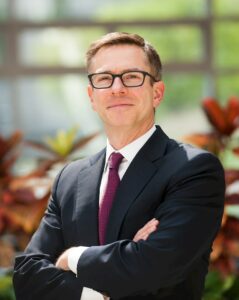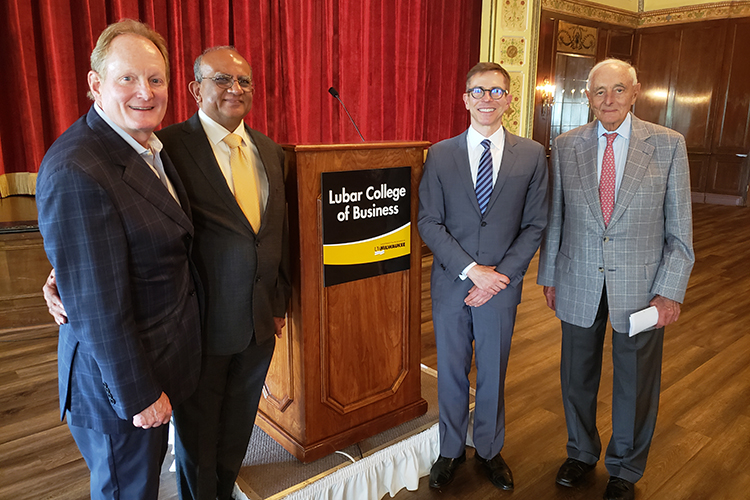
Economist Randall S. Kroszner presented a late June Bradley Distinguished Lecture Series audience with a comparison of the two most recent financial crises – the global financial crisis of 2008-09 and the pandemic-related financial crisis – and why one has led to high inflation where the other did not.
Primarily, he says, the difference lies in fiscal response.
Kroszner is the Norman R. Bobins Professor of Economics at the Booth School of Business at the University of Chicago. From 2006 to 2009, he served as a Governor of the U.S. Federal Reserve System, where he took a lead role in developing responses to the earlier financial crisis.
In response to both crises, he says, the government pumped a lot of liquidity into the system. In response to the global crisis, the Obama administration advanced a $1 trillion spending package commonly referred to as “quantitative easing.”
But during the pandemic, the combined Trump and Biden administration packages pumped three times that amount– $3 trillion – into mostly untargeted spending that impacted broad swaths of the economy and bolstered consumers’ disposable income.
While hindsight has called that massive pandemic spending into question because of the inflationary pressures that resulted, Kroszner says, ”At the time, it was a reasonable response to a shock that we understood very little about and that effectively closed the economy down in a way that never happened before – even sharper than the Great Depression.”
But something was also amiss in the U.S. Treasury securities market, which Kroszner calls the “lynchpin area” for almost all financial markets in the world.
“If people feel that they can’t get in and out of treasuries, they’ll get rid of other assets,” he says. “And that’s what happened in late February-early March 2020, resulting from this lynchpin market not functioning, coupled with the uncertainty from COVID.”
The Fed’s response was to buy a lot of assets, and for a long period of time – for 18 months after the markets calmed down. (In comparison, he notes that the United Kingdom approached disfunction in its gilt market in Fall 2022 by buying back assets in a well-communicated, targeted, and temporary way, ending about 10 days after it started.)
What the Fed didn’t do, Kroszner says, was draw a distinction between fiscal stability and monetary policy. As it continued to try to stabilize the treasuries market by buying assets, interest rates came down to zero. This, on top of the enormous fiscal stimulus, resulted in a significantly higher inflation during pandemic crisis recovery compared to the financial crisis recovery.
In addition, unemployment rates dropped dramatically in just a year after the pandemic crisis, compared to a much slower recovery from the financial crisis, where it took about five years to bring the unemployment rate down.
This dramatic difference in labor market recovery, fiscal stimulus, and monetary stimulus during the ongoing pandemic recovery led to an imbalance in supply and demand, and ultimately to price increases.
Kroszner does give some credit to the U.S Federal Reserve for being one of the first central banks to pivot when it recognized that inflation wasn’t going to be transitory, as originally hoped, noting that the European Central Bank continued to have negative interest rates until the summer of 2022.
How does he believe we can break the back of inflation?
“It’s very important that we pull back monetary stimulus, and the Fed is reducing the size of its balance sheet and has stopped buying assets,” he says.
Kroszner also says that the Fed needs to continue to raise interest rates, which it has been doing more quickly than at any time since the late 1970s under Paul Volcker’s leadership.
Inflation has come down considerably over the last 6 months, so he believes things are moving in the right direction.
But one thing that he says is making inflation more persistent is the labor market. Labor costs are still rising much higher than inflation, resulting in higher costs for products and services. Though commodity prices have been declining, he says that labor costs — especially those associated with the service sector — will make it difficult to achieve the Fed’s stated 2% inflation goal, which Fed chairman Jerome Powell thinks could be reached in 2025.
Kroszner projects that the Fed will continue to raise rates to 5.5-5.75%, and that inflation will stay on a slow downward trajectory to the 3-4% range.
All this said, Kroszner thinks it will be difficult – but not impossible – to bring inflation down without a significant slowdown or potentially even a recession.
In addition to serving on the Federal Reserve Board of Governors, Kroszner was a member of the U.S. President’s Council of Economic Advisors from 2001 to 2003, where he worked on issues including sovereign debt restructuring, currency crisis management, financial regulation, and corporate governance. Dr. Kroszner was recently appointed by the United Kingdom’s government as an external member of the Bank of England’s Financial Policy Committee (FPC). The FPC is the UK’s macroprudential regulator whose objective is to protect and enhance the stability of the UK’s financial system by identifying, monitoring and addressing systemic risks.
The Bradley Distinguished Lecture Series provides important insights into economic policies and actions that reinforce people’s faith in American democratic capitalism and free enterprise, and foster America’s global economic competitiveness, entrepreneurialism, and innovation.
The Series is sponsored by the Lubar College of Business and The Lynde and Harry Bradley Foundation.
